Malta
Malta, December 2014
Malta is in the Mediterranean Sea, south of Sicily and east of Tunisia.
Map of Malta and Gozo
Gozo is 67 km 2 and Malta is 316 km 2. The city of Toronto is 620 km 2.
About 37,300 people live on Gozo while Malta has a population of just over 423,000.
***
Water and Walls
Malta has a long and storied history. One of the famous incidents in its history is the Siege of 1565 when the Ottoman Empire invaded Malta. Although Sultan Suleiman the Magnificent had up to 40,000 men, the Maltese under the Knights Hospitaller (aka Knights of St. John or Knights of Malta) won.
Valletta is built on the Sceberras penninsula on the east coast of Malta. Prior to 1565 it was uninhabited. After the siege, the Knights planned the city as a refuge to care for injured soldiers and pilgrims during the Crusades in the 16th century. They also realized that if they were going to defended themselves from further attacks, they were going to need better fortifications. Grand Master La Valette drew up a plan for a new city including walls between the city and the Mediterranean Sea on all sides.
below: Looking out to sea.
The red dome is the roof of a church, Our Lady of Liesse.
It is possible to walk along the wall, or just outside the wall for most of its length. So I did.
Parts of the walk are better developed than others. In many places I was the only person and I often wondered if it was low tide or high tide (and should I worry?)
Uphill, downhill, and more uphill!
The Sceberras penninsula is very hilly. When La Vallette laid out his city, he used a grid system for the streets. As a result, Valletta’s streets are straight – often straight up and down hill. For instance, I was standing in the middle of the street for this:
Dome of Our Lady of Mount Carmel (Carmelite Church) on Triq Zekka
***
In Remembrance
Malta is full of statues and memorials. Some of the ones that I saw are below.
below: “Drowned by a boat upsetting in Tunis Bay, 3 Nov 1864”

All of the H.M.S. ‘Orlando’: Lieut. A.P. Still, Captain E.F. Pritchard, Surgeon C.B. Wood, Assist Paymaster B. Stratford, Dr. V. Da Gama of the Portuguese Navy, Midshipmen B.W. Fielding and S.B. Kemble, Quartermaster C. Arthurs, Masters Assistant W.C. Hadrill, Private W. Easterbrook and W. Fitzsimmons and J.G. Webber.
***
Laundry day in Valletta
The first time I walked through Valletta was on a Sunday. I saw many balconies with laundry hung out to dry and I thought, “Sunday must be laundry day, strange”. I returned to Valletta on a Tuesday and there were just as many balconies draped with laundry. “Ah” I thought “everyday is laundry day”.
***
Corner saints and others
Many intersections in Valletta, and other towns, have statues of saints and other figures built into the corners of the buildings.
below: written on the pedestal is:
“INDULGENZA
DI CENTO GIORNI
TOTIES QUOTIES
A CHI RECITA
DAVANTI A QUESTO SIMULACRO
SANCTE JOSEPH
OR PRO NOBIS
22 MARZO 1921”
***
Ta’ Braxia Cemetery, Floriana
A little overgrown but still an interesting piece of history.
below: A tombstone for Edward George Boyle who died in October 1898 after the Battle of Omdurman. And here is one of the reasons why I am so slow to go through my Malta pictures: I have never heard of the Battle Omdurman so I have to research it! It was one of the battles of the Mahdist War (aka Anglo-Sudan War) between Sudan and the combined Egyptian and British forces, a British colonial war.
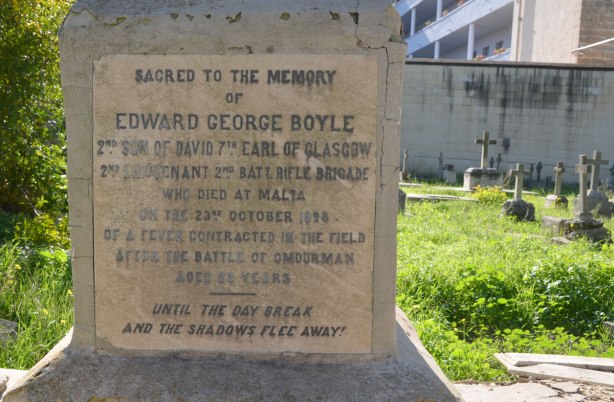
There are many children buried here. Some are buried alone alongside other children, including Wee Daisy, Wee Freddy and Dear Little Lucy.
and some are buried and/or memorialized with their families including Margaret McKean (?) and her three children Norah Ann, Harold Victor, and David William Evans.
Many of the gravestones are for military men.
Many different nationalities are represented here including Duang Yuen Fou (below), a Tonkinese soldier in the French army. If I am not mistaken, Tonkin was a region in the north of Vietnam. “Priez pour lui” translates to “pray for him”.
On 18 February 1918 the French steamer “Basque” was hit by a torpedo from a German U-boat near Malta. It was damaged but not sunk. Samba Sidibe, sailor, died that day.
below: This tombstone caught my eye because of the name, Thomas Teed. My great great grandmother was Mary Rose Teed, born in Boston England in 1824 and died in Toronto in 1898. He father was a mariner and Mary’s siblings were born in various places including Canada, USA and Australia. She didn’t have a brother Thomas. I did a bit of searching and discovered that this Thomas Teed was born in Red Hills Madras India. Chances are remote that he’s related, but you never know! Maybe Mary’s nephew?
After the Russian Revolution in 1917, about 800 (undocumented, exact numbers unknown) Russian refugees fled that country via Malta. Only a handful stayed in Malta, including this couple: Prince Michael Poutiatine and his wife Princess Catherine Poutiatine. They arrived in Malta in 1919 and they died there a number of years later.
***
On the western coast, near Dingli
There is a road that runs along the top of the cliff beside the Mediterranean Sea.

A narrow bumpy dirt road with a stone wall beside it. On the wall are a number of handpainted signs on wood that say private in a number of languages.
***
St. Johns Co-Cathedral, Valletta
The main altar from halfway back
Looking towards the back of the cathedral nave. 
Chapel of Aragon
***
Floor tiles
St. Johns Co-Cathedral, Valletta
Every square inch of the floor is covered with memorials in black, white, and shades of yellow and gold. There are numerous angels, skeletons and skulls.
***
St. Julians, a town on the east coast, just north of Sliema
It is a town with a mix of old and new.
Like most Maltese towns, it is built on a hill.
It rained one afternoon when I was walking around.
***
Love in St. Julians
A work by Richard England.
Apparently the word LOVE might be inverted so the word appears correctly when it is reflected in the water of Spinola Bay behind it. Hmmmm…..
But the word is still backwards when seen in the reflections in the wet pavement.
***
Words on a St. Julians street
Painted on the pavement is a line from Allen Ginsberg’s poem ‘Howl’
- ‘Howl’ was published in 1956 and the next few lines are:
- “I saw the best minds of my generation destroyed by madness, starving hysterical naked,
- dragging themselves through the negro streets at dawn looking for an angry fix,
- Angel-headed hipsters burning for the ancient heavenly connection
- to the starry dynamo in the machinery of night,”
***
Mnajdra and Hagar Qim
Mnajdra and Hagar are both prehistoric megalithic temples dating back to the fourth millenium BC. They are located a short walk from each other on the south coast of Malta. Both are UNESCO World Heritage Sites.
They are built of limestone. Hagar Qim is globigerina limestone which is softer and erodes more easily than the coralline limestone used in Mnajdra. A protective cover now stands over the sites to protect them from the elements. The sites are similar to each other. Many of the rocks are decorated with indentations. Hagar Qim photos:
Mnajdra photos:
***
The Romans in Malta – Roman Villa (Domus Romana), Rabat
A small, partially restored, house is the focus of a museum in Rabat.
The Romans conquered Malta about 218 BC when the Roman general Tiberius Sempronius Longus stopped on Malta on his way to Carthage at the beginning of the second Punic War (218-201 BC)

In the center of the mosaic floor of the courtyard is a picture of two doves drinking from a bowl. Apparently it is a famous motif and is copied from a painting by the artist Sosos. Many copies, or similar motifs, have been found in Pompeii, Rome, and other cities where the Romans lived.

***
Underground in Rabat
In 60 A.D. Paul the Apostle (St. Paul) and his group of missionaries were shipwrecked off the coast of Malta. According to tradition, the Apostle took refuge in a cave, now known as St. Paul’s Grotto in Rabat. They spent the next three months on the island.
There are a number of catacombs in Malta including a couple in Rabat. From the 3rd to the 6th centuries a complex system of underground burial grounds was developed outside Mdina, the medieval capital of Malta. Roman law prohibited burials within the city. The town of Rabat was subsequently built over these catacombs. Today Rabat and Mdina are adjacent to each other – Mdina within the walls, and Rabat just outside.
They are interesting to walk around in, and rather creepy when you’re alone down there even though all evidence of their original purpose has been removed. The cramped spaces and lack of contrast make for rather boring photos though.
***
Tempting, so very tempting!
A wonderful old abandoned (or at least empty) house in Rabat.
***
Mosta, a pleasant town in the center of Malta.
***
Mosta Church, Exterior
Although it is often called the Mosta Dome or Mosta Rotunda, the English name of this church is The Church of the Assumption of Our Lady. It is also known as the Rotunda of St Marija Assunta or in Maltese, Knisja Arċipretali ta’ Santa Marija.
The Rotunda was designed by Maltese architect Giorgio Grognet de Vassé. It took just over 30 years to build and was consecrated in 1871. Like most churches in Malta, exterior photos are difficult to take because of the proximity to other buildings.
Carved into the limestone of the architrave is “Virgini Syderibus Restitutae T. H. Mustenses” This loosely equals “The people of Mosta built this temple to the Virgin Mary carried into heaven, 1857”.
St. Paul (St. Paulus)
St. Simon stands in a dark corner by the front door.
St. Bartholomew
***
Inside The Rotunda
The massive dome of the Rotunda (40 meters in diameter) is claimed to be the third largest church dome in Europe (by diameter), superseded only by St Peter’s Basilica in Rome and the Hagia Sophia in Istanbul. Its design is closely based on the dome of the Pantheon in Rome.
The central part of the nave was cordoned off. As a result, taking pictures of the altar and the space behind it was difficult. The altar can just be seen on the left side of this photo.
oops…. yes, I was there!
***
St. Andrews (Hal Dimag)
in Mosta, Malta
This small square church is at the end of a residential street in the town of Mosta.

It was built in 1657, probably on the site of an earlier church. In 2002 it was restored to prevent it from collapsing. It is unused at the present time.
 The small marble plaque at the top corner of the door reads “Non gode l’immunita ecclesias”. These Latin words appear on at least two Maltese churches and it translates to “Does not enjoy Eccleslastical immunity“. It means that the Right of Sanctuary was revoked for these chapels. Anyone in trouble with the law can’t seek shelter and claim protection from arrest and prosecutions in these chapels.
The small marble plaque at the top corner of the door reads “Non gode l’immunita ecclesias”. These Latin words appear on at least two Maltese churches and it translates to “Does not enjoy Eccleslastical immunity“. It means that the Right of Sanctuary was revoked for these chapels. Anyone in trouble with the law can’t seek shelter and claim protection from arrest and prosecutions in these chapels.
***
National Shrine of the Blessed Virgin of Ta’ Pinu
in Gharb, Gozo
Part of the history of this church from gozochurches.com
“Until 1883, it was just another wayside chapel. On June 22 that year, Karmni Grima, a peasant spinster from the neighbourhood received a mysterious call from the altarpiece: Recite three Hail Mary’s in honour of the three days that my body rested in the tomb. The secret was not broken until two and a half years later, when a woman was miraculously cured after the Blessed Virgin Mary of ta’ Pinu had been invoked. Many pilgrimages to the spot were organized by the beginning of 1887. The Ecclesiastical Authorities, very cautious at first, understood the Virgin Mary’s message. Innumerable difficulties had to be overcome before the foundation stone of the new sanctuary could be laid on 30 May 1920. The new monumental sanctuary was consecrated on 13 December 1931. The Assumption was crowned by a papal decree on 19 June 1935. On 26 May 1990, Pope John Paul II placed a halo of stars around the Virgin being assumed into heaven.”
***
Translation fun
There is a lot of English used in Malta. It was a British colony, and part of the Commonwealth after all. It gained its independence in 1964.
The following pictures are of some of the interesting uses of English that I saw.
They all brought a smile to my face.
***
Graffiti under the sidewalk
Along the shore at Sliema.

Shoreline rocks and wall under the sidewalk. Where Triq it-Torri meets Ix-Xatt ta’Quisisana in Sliema
***
Mdina by day
Mdina is a totally walled city with narrow lanes and alleys.
It dates from the 1500s and it is home to 300 people.
***
St. Pauls Cathedral, Mdina
The present building was designed by the Maltese architect Lorenzo Gafa and it was built between 1697 and 1702. It replaced an earlier church that was destroyed during an earthquake in 1693.
***
Mdina at night
The lamps that light the streets at night are covered with yellowish orange glass.
***
Narrow streets of Birgu
Birgu, or Vittoriosa, is one of the Three Cities across the Grand Harbour from Valletta. Many buildings date from the 1500`s.
***
House names
Many houses in Malta have names. These names are on plaques and signs by the front doors of the houses. The following are a collection of names that I saw.
Some houses are named after other places.
There are many religious references. Anything to do with Mary (St. Mary, Mary, Our Mary of the Grotto, etc) is very popular. St. Joseph and St. Paul were also common names.
Some houses have names that are people’s first names.
And lastly, some houses are named after things.
***
Mary’s in Malta
Once upon a time I blogged about how many Marys I saw in Peru. I now know that there are far more Marys in Malta than there are in Peru! This afternoon I had 20 minutes to wait for a bus so I decided to see how many Marys I could find in that time. I was in Victoria (Rabat) Gozo.
Like many Marys, this one was on an exterior wall of a house.
At the top of St. Francis Church, Victoria Gozo
on the front of more houses
I didn’t want to cross the ‘street’ to get a close-up picture. It was a narrow street and there was no room for pedestrians on the other side.
I didn’t cross the street to take a close-up of these Marys because I loved the chaos of the tiles around the doors!

Three more Marys. The one on the right has ‘Gandlora’ written beside it.
Il-Gandlora celebrates the presentation of the infant Jesus at the Temple in Jerusalem by his parents Joseph and Mary. It occurs on the 2nd of February and it is known as Candlemas in English.
This Mary, in her own stone case, stands above the arch over a road. She wasn’t one of the Marys that I saw in my 20 minute walk, but she was the one I saw just before I realized I had some time to wait. She got me thinking.

























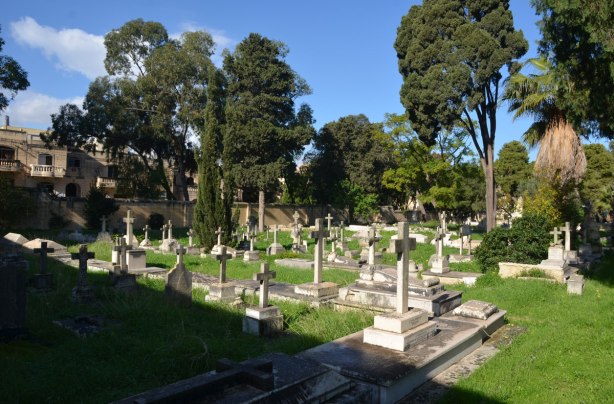










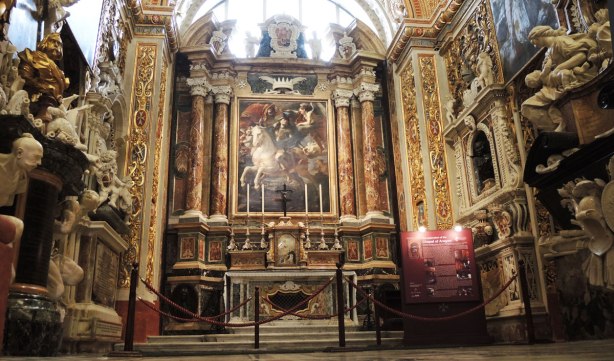

















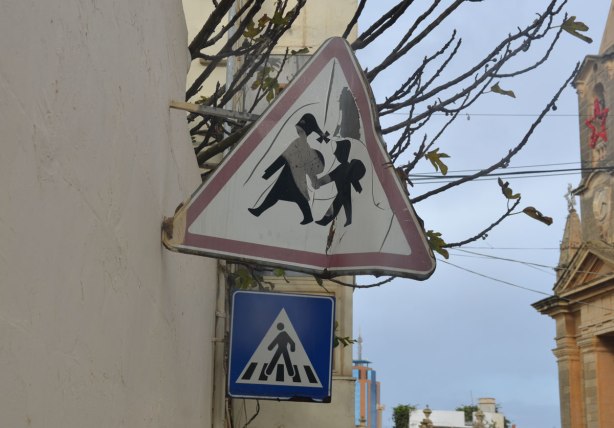











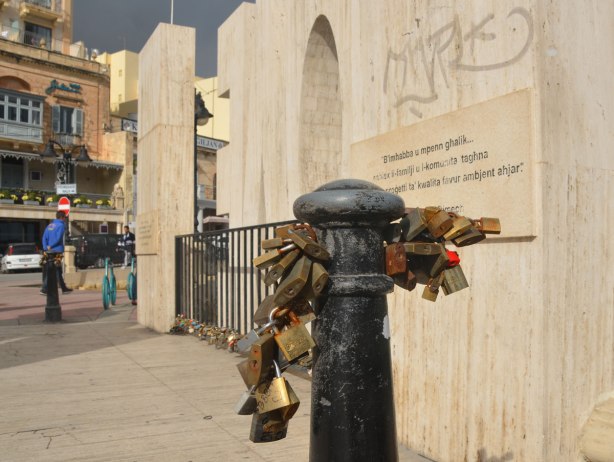







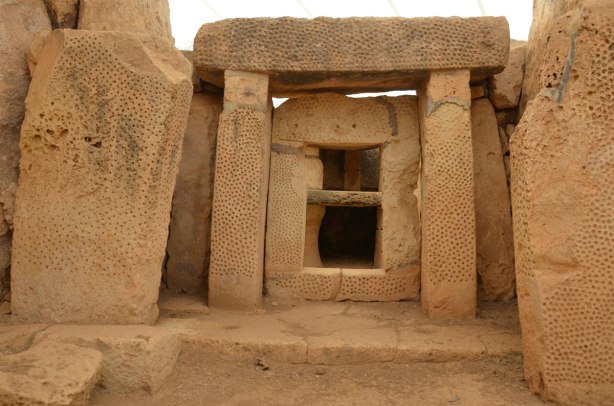



























































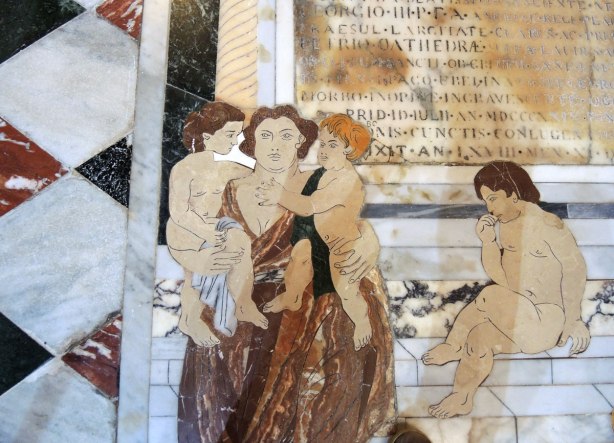

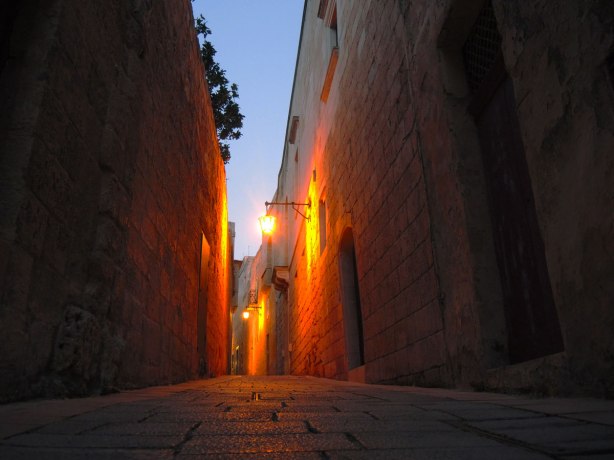














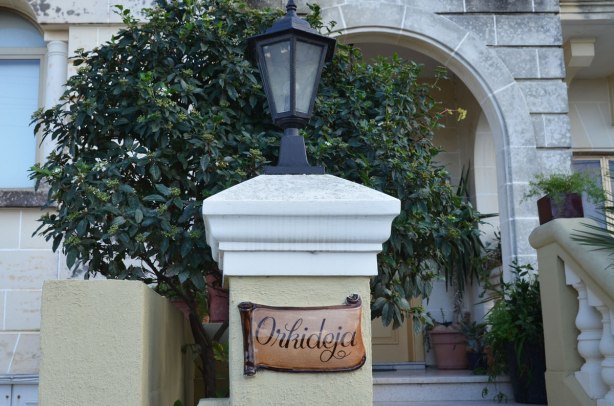






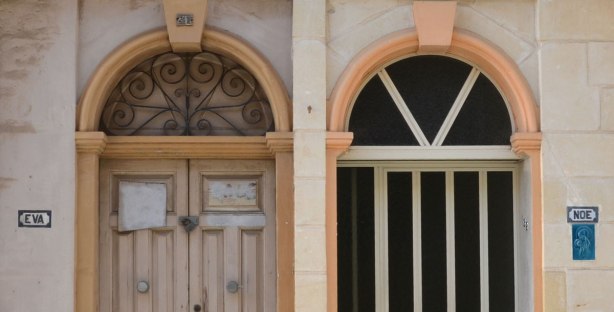












[…] Malta […]
Love these street images of Malta …. It’s now on my bucket list! Oh and have a very “Mary” Christmas!
There’s more to come! I started falling asleep aa I was trying to upload the Birgu pics….. very slow internet connection plus a bit of a cold unfortunately. Once I’m home I should have some time to work on it!
how can I find the abandoned building in rabat?
I’m not sure. I took the picture a year ago. It might be on the main road as you head out of town, away from Mdina, southwest towards the coast maybe? I am fairly certain I saw it the day I walked from Dingli to Mdina